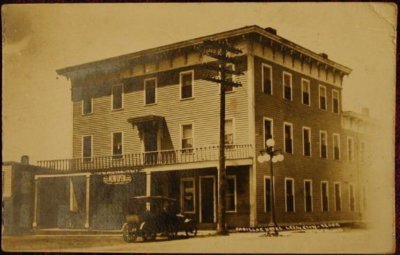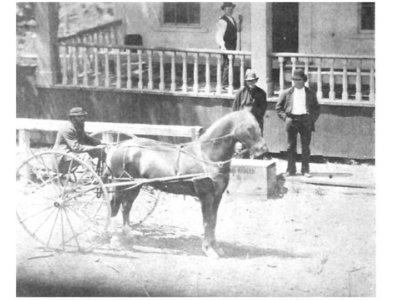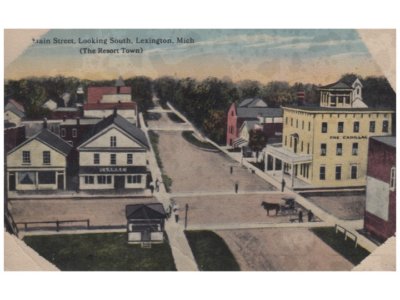 The Cadillac House is listed on the National Register of Historic Places. It was built to accommodate visitors drawn to the area during Lexington’s “golden era” of the mid-nineteenth century, when it served as a significant center for the lumber and fishing industries in Michigan’s Thumb and a major transshipment point for goods and materials on the Great Lakes.
The Cadillac House is listed on the National Register of Historic Places. It was built to accommodate visitors drawn to the area during Lexington’s “golden era” of the mid-nineteenth century, when it served as a significant center for the lumber and fishing industries in Michigan’s Thumb and a major transshipment point for goods and materials on the Great Lakes.
A National Treasure
Beginnings
The village of Lexington is located on the eastern shore of Lake Huron, just north of where the lake channels into the St. Clair River at Port Huron. The first EuroAmerican settlers in the area were attracted by the large timber stands of the Thumb region, and lumber was the earliest industry in the region. Later, given the Village’s strategic location on Lake Huron, fishing supplanted lumber as the village’s principal industry, continuing into the early twentieth century. Settlers first arrived in the Village, originally named Greenbush, around 1835. The Village was renamed Lexington around 1845, reportedly in honor of Lexington, Massachusetts.
Lexington was initially designated as the county seat for Sanilac County, making it the oldest town in the county. Clark Mills, owner of the Mills Hotel, sat on the first board of supervisors of the county in 1848, and was later elected a Judge of the Probate Court in 1850. Lexington incorporated as a village in 1855 and remains a village today.
Port Town
In the mid 1800s, Lexington was a bustling port, with a large lake trade and a strong market. The timber stands of the Thumb region were being heavily harvested during this period, and Lexington was the center of the industry in the region. Farmers who had purchased the land cleared by the lumber industry could bring their crops and livestock to Lexington to be shipped out from the village’s docks. Many successful lumber businessmen lived in Lexington during this period, and the town likewise attracted carpenters and woodworkers, and various support industries. As a result, larger hotels were needed to accommodate the increased traffic.
Grand Opening and Namesake
In 1859, the Cadillac House was built. Its grand opening was held on the 4th of July, 1860 and celebrated with a parade and ball. A steamer ship brought guests from Detroit for the occasion. While there are conflicting reports, it appears that Jeremiah Jenks, a Lexington local, built the hotel and served as its first proprietor. Records show the new hotel had eight guests – two clerks, a forwarding agent, two laborers, a physician, a law student, and a carpenter.
The Cadillac House was named after General Antoine De La Mothe Cadillac, the founder of Fort Pontchartrain, later Detroit. The main part of the hotel was a three-story Italianate structure clad in painted clapboard siding.
The Late 1800's
In the later 1860s, the hotel was becoming increasingly popular. Newspaper reports noted that prospectors crowded into the Cadillac House during the great oil craze and speculation of 1864-65. Oil had reportedly been discovered in several areas around the Thumb and prospectors flooded into the area hoping to find more. In addition to hosting hotel guests, the Cadillac House was also used as a wedding venue and, along with the second floor of the nearby city hall (constructed 1876), was a social center for the Village.
During the 1870s, the Cadillac House was plagued by several fires, not in the hotel itself, but in the attached livery stables. In October of 1871, not long after the Great Thumb Fire, which had burned a large portion of the Thumb region but had spared Lexington, fire destroyed several buildings adjacent to the Cadillac House. This fire was one of several from around the same period of time, leading the authorities to suspect arson.
By 1880, there were several other hotels in town, but none as large as the Cadillac House. Around that same time, the county seat of Sanilac was moved from Lexington to Sandusky, located in the center of the county. While this removed the county government from Lexington, the Village remained a center for the lumber and fishing industries in the region.
By the late nineteenth century, [The Detroit Free Press described the Cadillac Hotel as “a charming retreat for the summer months, noting that it had “thirty commodious rooms, well-ventilated and lighted and overlooking the lake. Large and well-furnished parlors are on all floors, and the table is well supplied with the wholesome delicacies of the season.”] The hotel rates at the time were $2 per day or $8 per week. At its largest, the Cadillac House had some 30 rooms available for overnight stays. The same article noted that Lexington was a “growing town and new resort on Lake Huron.” It could be accessed by steamers and freighters on their way to and from Port Huron, or by train to Croswell and then by bus to Lexington. The town itself was situated on a hill above the lake, the article noted, giving the advantages of “the health-giving lake breeze” and making it “the most healthy spot in the state.”
The Turn of the Century
By the early years of the twentieth century, many of the Village’s major industries had closed, including the local brewery, foundry, and organ factory. The woolen mill burned in 1900 and its operations moved to Port Huron. Another major blow came with the great freshwater hurricane of 1913; in addition to the loss of many ships and lives during the storm, Lexington’s docks were severely damaged by the storm, and much of the shipping for the Thumb region that had previously centered on Lexington was moved down to Port Huron.
As industry declined, the resort business became increasingly important to Lexington. The city’s convenient distance from Detroit and Port Huron and location right on Lake Huron drew guests for sport fishing, swimming, and sightseeing along the lake. Dining was also a draw, and the owners of resort hotels, including the Cadillac House, benefited from tourist traffic. With the change from business travelers to resort visitors, the hotels in the area evolved into seasonal businesses and by the mid 1910s, the Cadillac Hotel was largely a seasonal operation, opening in the spring and closing back down in the fall.
New Owners and Post-War
By 1940, the Cadillac House was renamed the “Rice-Cadillac Hotel, “ after its new owner and manager PJ Rice. The hotel itself was still open at that time, with 25 rooms listed starting at $1.50 per night, and was advertising a new cocktail bar, after more than a very long decade beginning with Prohibition where alcohol wasn’t served on the premises.
In the mid 1940s, even with the Depression still in recent memory and World War II in progress, the resort industry continued to be important to economy of the Lexington area. A 1943 article on the resort industry noted that Lexington was the Thumb’s “biggest little town” and marketed itself to tourists and war workers for relaxation and rest. Visitors to the Cadillac House enjoyed seven course fish, steak, or chicken dinners costing between 85 cents and $1.25, and dancing was offered on the weekends.
Mid 20th Century to Present
By the late 1950’s, however, the resort era of the early to mid twentieth century was in decline. The greater range of automobiles meant that visitors could plan day trips to towns like Lexington from Port Huron or Detroit. Small, old hotels like the Cadillac were less attractive than the modern motor courts and roadside motels that were appearing across the country. The last year that hotel rooms at the Cadillac House were advertised in 1954 and by the late 1950’s, the Cadillac House was being marketed only as a bar and restaurant.
Despite the decline of its identity as a hotel, the Cadillac House remained a popular dining room and bar for the next half century.
The hotel was extensively remodeled in the 1970’s with the addition of mansard roofs to the first and second floor porch roofs and the later addition to the exterior of the stucco and wood paneling and over-sized A-frame door porticoes giving it a ‘Swiss chalet’ appearance. All of these modernization’s were removed as part of the just completed historic restoration.
In 2001, the Cadillac House was sold to Martin and Julia O’Brien. The O’Briens owned and operated the Cadillac House as a popular bar and restaurant until they sold the property to the current owners in August of 2016.





